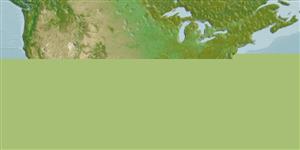Environment: milieu / climate zone / depth range / distribution range
Ecologia
marinhas; estuarina demersal; intervalo de profundidade 1 - 43 m (Ref. 89891). Subtropical; 37°N - 9°N, 98°W - 59°W
Western Atlantic: Virginia to Texas in USA, northern Mexico, south to Trinidad and Tobago.
Tamanho / Peso / Idade
Maturity: Lm ? range ? - 35 cm
Max length : 83.0 cm TL macho/indeterminado; (Ref. 40637); common length : 50.0 cm TL macho/indeterminado; (Ref. 3275); peso máx. publicado: 9.3 kg (Ref. 4699); idade máx. registrada: 8 anos (Ref. 46275)
A cryptic species that tolerates low salinities; occurs frequently in brackish bays and estuaries, even on occasion in fresh water (Ref. 9988). Minimum depth is at 0.7 meters (Ref. 128969). Adults are found mostly over mud bottoms in estuaries and coastal waters to about 40 m depth. Taken by anglers inshore from bridges, jetties and small boats. They move to deeper water in winter, but are still easily accessible (Ref. 9988). Adults feed chiefly on fishes, also on crabs and shrimps. Juveniles take mainly small bottom-living invertebrates. Marketed fresh and frozen; eaten steamed, fried, boiled, microwaved and baked (Ref. 9988).
Ciclo de vida ou comportamento de acasalamento
Maturities | Reprodução | Spawnings | Egg(s) | Fecundities | Larvas
Distinct pairing (Ref. 205).
Robins, C.R. and G.C. Ray, 1986. A field guide to Atlantic coast fishes of North America. Houghton Mifflin Company, Boston, U.S.A. 354 p. (Ref. 7251)
Status na Lista Vermelha da UICN (Ref. 130435)
Ameaça para os humanos
Harmless
Uso pelos humanos
Pescarias: espécies comerciais; peixe esportivo: sim
Ferramentas
Relatórios especiais
Baixar XML
Fontes da internet
Estimates based on models
Preferred temperature (Ref.
123201): 23.2 - 24.9, mean 23.9 °C (based on 168 cells).
Índice de diversidade filogenética (Ref.
82804): PD
50 = 0.5000 [Uniqueness, from 0.5 = low to 2.0 = high].
Bayesian length-weight: a=0.00575 (0.00365 - 0.00908), b=3.19 (3.06 - 3.32), in cm total length, based on LWR estimates for this species & Genus-body shape (Ref.
93245).
Nível Trófico (Ref.
69278): 3.5 ±0.48 se; based on food items.
Resiliência (Ref.
120179): médio(a), tempo mínimo de duplicação da população 1,4 - 4,4 anos (K=0.21-0.23; tmax=8).
Fishing Vulnerability (Ref.
59153): Moderate vulnerability (44 of 100).
Nutrients (Ref.
124155): Calcium = 59.8 [28.1, 127.9] mg/100g; Iron = 0.832 [0.414, 1.467] mg/100g; Protein = 16.8 [14.4, 20.0] %; Omega3 = 0.177 [0.092, 0.329] g/100g; Selenium = 27.5 [13.9, 60.6] μg/100g; VitaminA = 5.32 [1.60, 17.66] μg/100g; Zinc = 0.618 [0.423, 0.918] mg/100g (wet weight);
